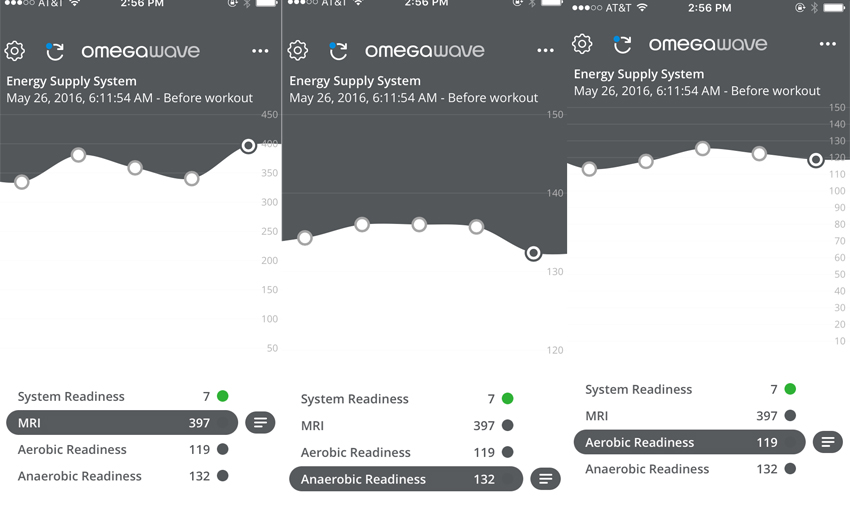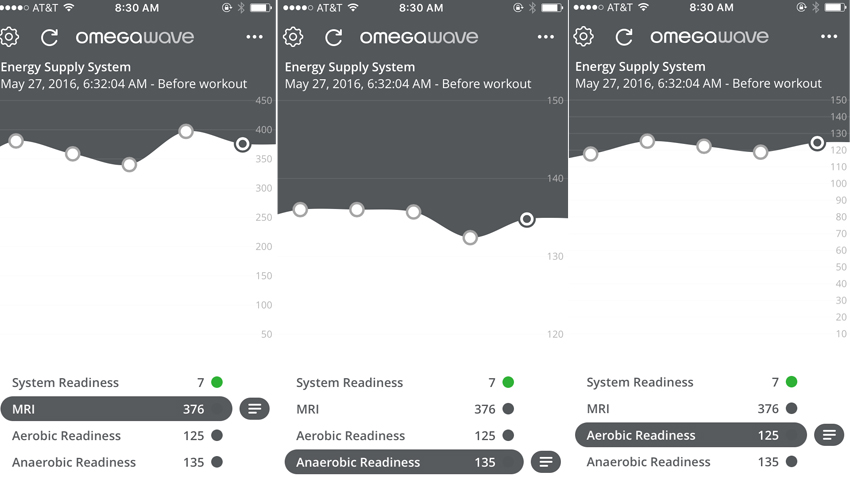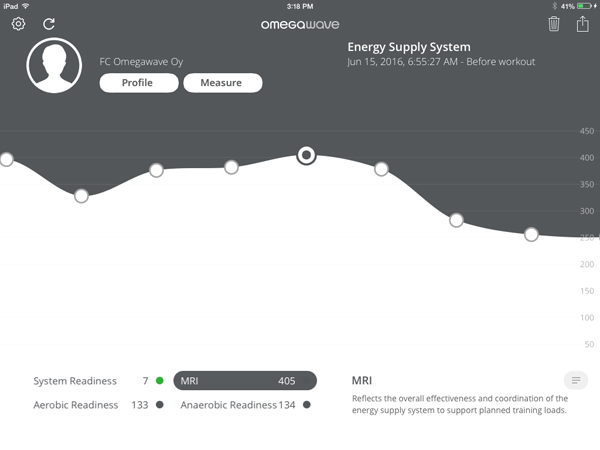In this series of educational posts, we will be engaging in informal Q&A sessions with Omegawave’s Co-founder Val Nasedkin and our Senior Research Scientist Roman Fomin, freely discussing the foundations of our technology and it’s practical applications. While our “Knowledge” section includes academic research papers and technical users guides, here we will attempt to narrow in on some of the basics, hoping to provide a better understanding of how to interpret and utilize the data our technology supplies.
Question: What exactly does Omegawave assess with our Energy Supply System indexes?
Roman Fomin: What we are trying to do is evaluate the efficiency of your (cardiac) “pump.” Imagine two situations, A and B. Situation A—your pump can do some contractions, but these contractions are weak, and therefore the pumping is weak. After each contraction, there is little volume of blood going outside because the pump is not strong and the contraction is not strong as well [Mimics weak pumping action with a limp squeeze of his fingers and palm]. Situation B—your pump is very strong and the contractions are strong as well. So, cardiac output is higher and velocity and strength are higher. Blood is going to the aorta faster and delivering oxygen faster to the muscles. A is a poor state, B is a good state.
The primary function of the cardiovascular system is pumping, but the purpose is to deliver oxygen to the brain, working muscles, tissues, and organs. Because without oxygen, we cannot function. Therefore, if I am doing a workout or exercise, I am contracting my muscles, and my energy must be recovered. And mostly it is recovered using oxygen.
Therefore, if my pump works great, my cardiovascular system works great—my muscles are getting oxygen on time without any problems and I can compete and perform. With the opposite situation, if my pump is bad, even if my muscles feel great, if my support system can’t deliver oxygen I will do one, two, three, four, five, ten minutes of contractions, and done—because, hypoxia. Not enough oxygen in my muscles.

Q: How do we extrapolate the functional state of an individual’s energy supply systems from an ECG?
RF: We don’t directly measure your metabolism—but based on an evaluation of your cardiovascular system, we can determine the general level of your energy supply systems.
What we are measuring is bioelectrical activity of the heart. Electrophysiological activity is an expression of biochemical processes—based on this bio-electrical activity analysis and evaluation, we can say how good or how poorly your heart is working. If your muscles are working very hard, it will lead to changes in your heart, and we can see these changes.
Q: How, specifically, do we evaluate this bioelectrical activity?
RF: We do this based on an evaluation of the relationships between different waves in the ECG —Q, R, S, and T waves. We are trying to compare all of them. We know what they look like when they’re in a normal state, we know a lot of abnormalities, and based on this analysis, we can say “hey, your heart works great—and even more, your heart has proper adaptations inside in response to your type of training, your heart is ready to do some type of aerobic workout and you already have good readiness and adaptations.”
Marathon runners, for example, have higher R-waves when their heart is contracting. We can see high R-waves and we can say “okay, you have a great engine for this kind of workout” or we can say “your aerobic index looks good and you are ready for an aerobic type of workout because your heart has the proper adaptations. Your heart can handle this type of load.” Or, we can say “look, during a whole cycle of training, say, one month, all of your parameters decreased. Aerobic decreased, energy supply systems decreased… we can see this negative trend effecting your engine.” So this training load leads to negative effects—in this case, you have to change this type of training if you want to develop this particular area.
Q: From this wave analysis, how are we able to differentiate aerobic and anaerobic Readiness?
RF: Changes in the T-wave are often related to anaerobic processes, while changes in the QRS-complex are related to aerobic processes.
The higher the QRS, the higher the MRI—the individual’s “pump” is working better. So if you have very low R-wave, little Q, and no S at all, your MRI will be very low. Your pump is… pfffft. But maybe you don’t need this type of pump, depending on your sport.
Val Nasedkin: As a coach, my job is to evaluate the cost every physical activity has upon my athlete. So, it means I need to know what type of activity the athlete did: Was it aerobic activity or was it anaerobic? How much did they do? Did they pay a high cost or a low cost? And the most important question is: when are they recovered from this workout, from an energy systems standpoint? I need to answer those questions.
In response to aerobic types of activities, we can observe changes in the QRS-complex of the ECG. So, by monitoring changes in QRS, we can see if the athlete’s aerobic system was involved in training, how much it was involved, or if it was suppressed. By monitoring tomorrow, and the day after tomorrow, and seeing changes in the ECG returning back to their initial levels, we can state when the compensation is complete.
So, when we apply anaerobic types of stressors, we will observe changes in the S & T segments. The same thing—we can see how much they changed, we can see what systems were stimulated, or what systems were stimulated and then to some degree even depleted. And then, of course, by continuing to monitor those parameters that represent these changes in the ECG, we can see exactly how much it was taxed, and how long it will take the system to recover. This data allows me as a coach to understand where on the supercompensation curve—from the standpoint of energy systems—my athlete is.
When the ECG shows a decrease in the efficiency of aerobic or anaerobic functions, I stay back and wait until the system has recovered. When it shows that the process is completed and the system is fully adapted to that load, that’s when I’m going to apply the next load.
Q: Is this why we typically suggest that our energy supply indexes should be looked at longitudinally?
VN: Yes. By looking at the ECG I can—in general—determine the efficiency of cardiac function, even from one assessment. But, like we said before, different sports require different levels of efficiency. So, just one data point is not as effective. But if we look over time we will see exactly how these systems respond to training, and when they are in a state of compensation, so additional loads can be applied. All of our data should just help us make a decision of when to apply a load. And this is one of the markers.
Q: Turning specifically to the MRI index, what is happening physiologically when the MRI is ascending, but both aerobic and anaerobic Readiness are descending?

VN: The MRI, in general, shows you the overall efficiency of the cardiac system. So, the higher the MRI, the higher the overall efficiency of contractions. Aerobic and Anaerobic, however, can respond in different ways to different types of training, so it’s quite possible that you can have an overall efficient system, but not necessarily greatly develop one or the other.
Q: So you can also have the opposite situation, where both aerobic and anaerobic indexes are rising, but MRI is going down? Is MRI not a function of these two sub-categories?

VN: Aerobic and Anaerobic can have their own trends. Both of them can go down, both of them can go up. MRI explains the efficiency of the relationship between those two—regardless of whether they are going down or up.
When I start training and I start adding stressors, my system decompensates. But, as my system decompensates, my fitness level, my actual state is improving. My efficiency is improving, even though all of my systems are going down. When I start resting, my system starts compensating, and my shape starts decreasing, actually.
Let’s say we have a horse cart. One horse is aerobic, one is anaerobic. Here, one horse—a small one—is pulling west. Another horse, also a small one, is pulling east. So, the cart is not moving anywhere. Now, let’s make these two horses a lot larger—they both grew significantly. Even so, the cart is still not moving anywhere. Why? Because there is no coordination between the two horses. So, two very large horses, pulling with all the power they can, and the cart is not moving anywhere.
Now, let’s go back to small horses. So, each system has decreased. But now, both small horses are pulling west—the same direction. They’re not as powerful, they’re not as strong, but is the cart going to move? Yes. Why? Because the relationship between these two horses is stronger. They are working in the same direction. So, the size of horse doesn’t mean anything in itself—either it’s going up or going down. It’s making sure they’re pulling in the same direction that matters. So, in a very simple way of explaining, MRI determines the relationship of these horses. The aerobic and anaerobic can determine the size of these horses—but not necessarily whether they are pulling together or not. So that’s why both of the horses can start getting bigger, but if they are moving in an incompatible direction, the MRI is going to go down—even if the aerobic and anaerobic both continue to go up.
Q: How much influence should aerobic and anaerobic Readiness have on your training plan?
VN: We are talking about patterns. The number itself doesn’t mean anything—the pattern does. If I see a constant decrease of the aerobic parameter, and a constant increase of the anaerobic parameter, this means the system has started compensating by activating an anaerobic mechanism during its recovery phases. And that’s not a good picture.

Everything we do is to validate the efficiency of training. Regardless of what activities you do—it can be aerobic or anaerobic—the actual compensation for this activity should always happen on the aerobic side. When you recover. So if I can see, day to day, anaerobic numbers climbing, it means the athlete’s system is compensating by activating anaerobic channels. And that’s not good. When the cardiac system is not very efficient, what is the defense mechanism of the organism? It keeps learning how to live anaerobically. If the cardiac system cannot deliver enough oxygen, there’s no other option but learning how to live with less oxygen. So we will see anaerobic continuing to climb, because the body is learning how to live without a sufficient oxygen supply. If I train very hard and I constantly get myself into an anaerobic state, my system will start adapting by creating a more and more efficient anaerobic system. But it’s not good for me. Because it also means I’m working too much in a state of hypoxia. So that’s why we need to look at patterns—and then you can evaluate the training process, how efficient it is.
Q: What pattern is a coach seeing when the aerobic index is continually dropping while the anaerobic continues to climb?
VN: Activities of too high an intensity can keep an athlete too highly hypoxic. When the body doesn’t have enough oxygen, it has no option but to start developing anaerobic abilities. But for sport that’s very bad.
If your anaerobic continues to go up, it means your system is oxygen-deprived. When you recover from training sessions, your system should NOT be oxygen-deprived. Don’t look at it only as your ability to do something—also look at it as how you are recovered. So, what mechanism is your body using to recover? Ideally, in all events, aerobic either maintains or continues to rise slightly, and so does MRI to a certain level. And anaerobic either stays flat or decreases. There are very few sports where an increase in anaerobic is positive.
Q: Why is anaerobic development a negative sign for field and combat sports?
VN: You are only as good as your ability to deliver oxygen and utilize oxygen—and clear the byproducts. In particular, clearing those byproducts depends on your muscle mitochondria. The more mitochondria you have in your muscles, the more lactate that you produce will be recycled into energy again. If you don’t have mitochondria in your muscles, then this lactate starts accumulating and your muscles shut down. So, what do we know about hypoxia? When you work anaerobically, and you get into a state of hypoxia, it destroys mitochondria. It destroys your ability to process byproducts that you are creating. That’s the problem. Now, for a sport like powerlifting, it doesn’t matter. Because they do maybe three lifts per day and then they are done. So, for them, having a very high anaerobic system is no problem. Or for someone who competes in the 400 meters. They run once, maybe another day they run one more time, and they are done. But for someone like a boxer, that has to box 12 rounds, that’s not the case. They have to be able to process the waste products all the time. Or a football player. How do you play 3 hours if you have big muscle mass—say you train anaerobically, so there’s very small amount of mitochondria—you start to use your muscle, it creates waste products. But you can’t offset it, so it starts to accumulate. After the first quarter, by the second quarter your muscles are done. They can’t function.
